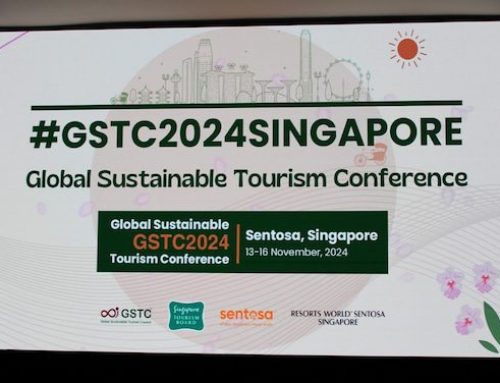Washington, DC (November 1st, 2013) Sustainable tourism is on the rise: consumer demand is growing, travel industry suppliers are developing new green programs, governments and international agencies are creating new policies to encourage sustainable practices in tourism. But what does “sustainable tourism” really mean? How can it be measured and credibly demonstrated, in order to build consumer confidence, promote business prosperity, foster community benefits, and fight false claims?
Announcing the Global Sustainable Tourism Council’s Criteria for Destinations – a global effort creating a common understanding of what constitutes sustainable destinations. The criteria are the minimum undertakings a destination should achieve. The Criteria focus on an integrative, interdisciplinary, and holistic approach which includes four main objectives: to (i) demonstrate sustainable destination management; (ii) maximize social and economic benefits for the host community and minimize negative impacts; (iii) maximize benefits to communities, visitors and cultural heritage and minimize impacts; and (iv) maximize benefits to the environment and minimize negative impacts. The criteria are designed to be used by all types and scales of destinations.
The Criteria are part of the response by the tourism community to the global challenges presented by the United Nations’ Millennium Development Goals. Poverty alleviation, gender equity and environmental sustainability, including climate change, are the main cross-cutting issues that are addressed through the criteria.
“The official release and publication on the GSTC Website of the first-ever Global Sustainable Tourism Criteria for Destinations marks a milestone in the world of travel and tourism globally. Our deepest gratitude goes to all the participants in this process, the volunteers, the NGOs, the Certification Bodies, all the stakeholders actively involved for some years in this wonderful project on a global basis. Above all our gratitude goes to the Early Adopters, brave and committed Destinations that have provided the immensely important field testing of the GSTC Criteria. From now on, all Destinations in the world willing to demonstrate their leadership in sustainability will as well be able to obtain from the GSTC, its Partner NGOs and its Partner Certification Bodies a full set of services to support them, from on-site evaluation, to training, to full certification. We’ll be delighted to provide them with the best tools at our disposal, and be at their side in their quest to secure a sustainable future through tourism to their populations, environment and enterprises.” expressed enthusiastically Mauro Marrocu, GSTC CEO.
The Destination Criteria and indicators were developed based on already recognized criteria and approaches including, for example, the UNWTO destination level indicators, GSTC Criteria for Hotels and Tour Operators, and other widely accepted principles and guidelines, certification criteria and indicators. They reflect certification standards, indicators, criteria, and best practices from different cultural and geo-political contexts around the world in tourism and other sectors where applicable. Potential indicators were screened for relevance and practicality, as well as their applicability to a broad range of destination types.
The Global Sustainable Tourism Criteria are administered by the Global Sustainable Tourism Council.
Some of the expected uses of the criteria by tourism management organizations include the following:
• Serve as basic guidelines for destinations which wish to become more sustainable
• Help consumers identify sound sustainable tourism destinations;
• Serve as a common denominator for information media to recognize destinations and inform the public regarding their sustainability;
• Help certification and other voluntary destination level programs ensure that their standards meet a broadly-accepted baseline;
• Offer governmental, non-governmental, and private sector programs a starting point for developing sustainable tourism requirements; and
• Serve as basic guidelines for education and training bodies, such as hotel schools and universities.
“This is a landmark event for sustainable tourism—the culmination of several years of work globally; substantiated by the “Early Adopter” programs, whereby groups all over the world committed to testing the processes and structures in diverse geographic environments” stated Dr. Kelly Bricker, Chair of the Global Sustainable Tourism Council. She added, “we are greatly encouraged by years of work and the participation of many certification bodies, our partners and the industry in support its development—a real step forward towards employing tourism to protect and enhance natural and cultural resources, and improve the quality of people’s lives.”
The Criteria indicate what should be done, not how to do it or whether the goal has been achieved. This role is fulfilled by performance indicators, associated educational materials, and access to tools for implementation from public, NGO and private sector providers all of which are an indispensable complement to the Destination Level Global Sustainable Tourism Criteria.
This updated version of GSCT Criteria proposes the minimum, not the maximum, which businesses and destinations should achieve to approach social, environmental, cultural, and economic sustainability.
A panel of business owners, academics, government officials, and other experts, who examined the UN World Tourism Organization’s Indicators of Sustainable Development and other such guidelines currently in existence, developed the GSTC’s Destination Criteria. Because the criteria are intended to describe a globally applicable set of minimum steps needed to approach sustainability, the criteria are seen as a baseline that each destination should add to or adjust as needed.
The GSTC does not aim to certify destinations as sustainable; rather, the Council will review existing certification standards and acknowledge those that meet their criteria. However, any destination will be able to use the new criteria as a guide to becoming environmentally, culturally, and socially sustainable.




